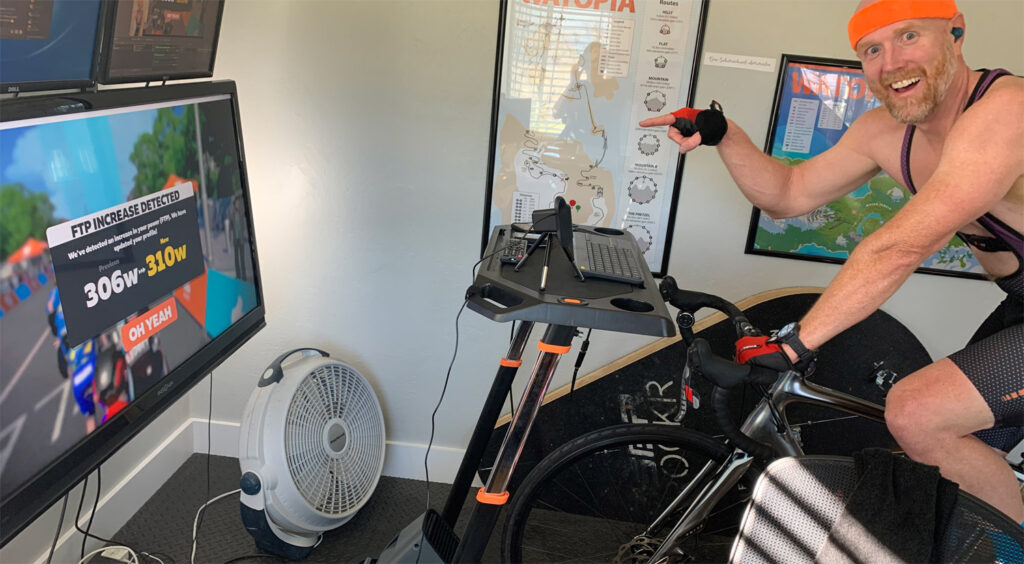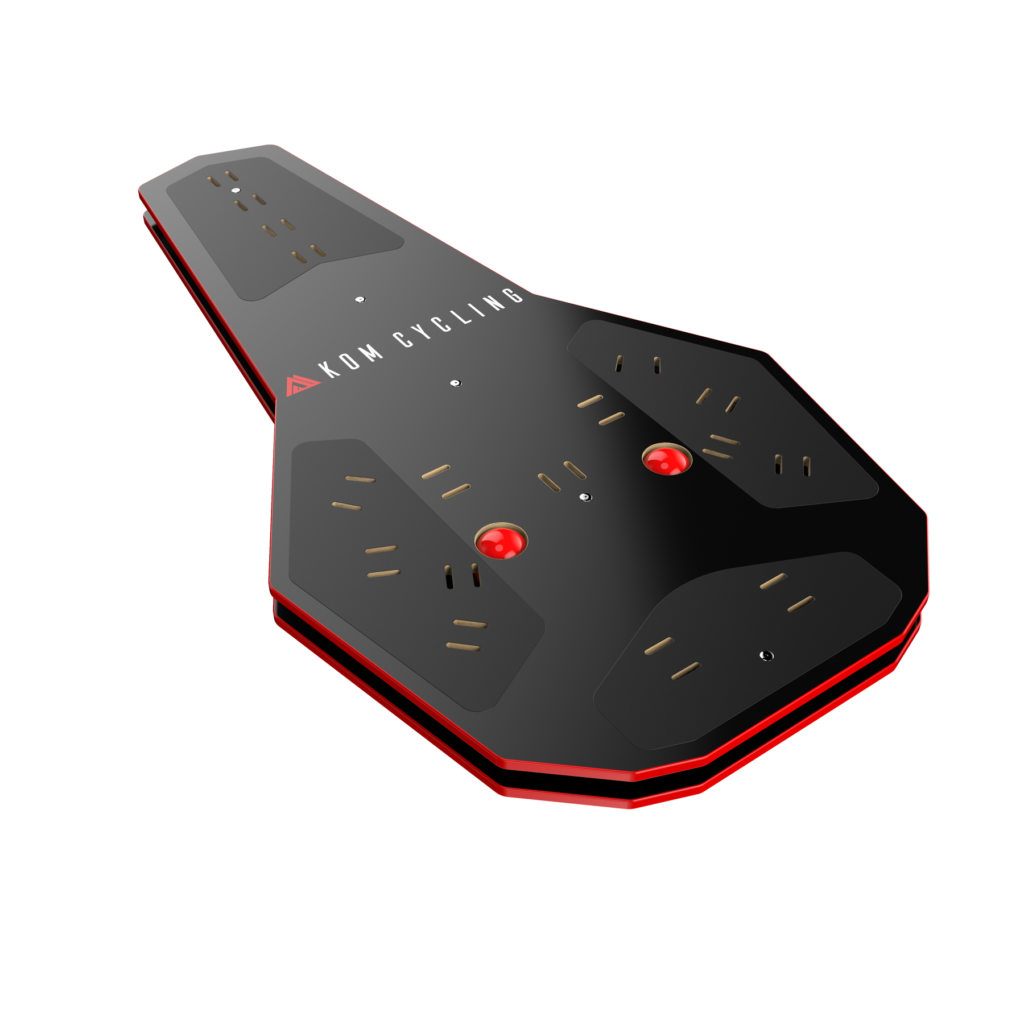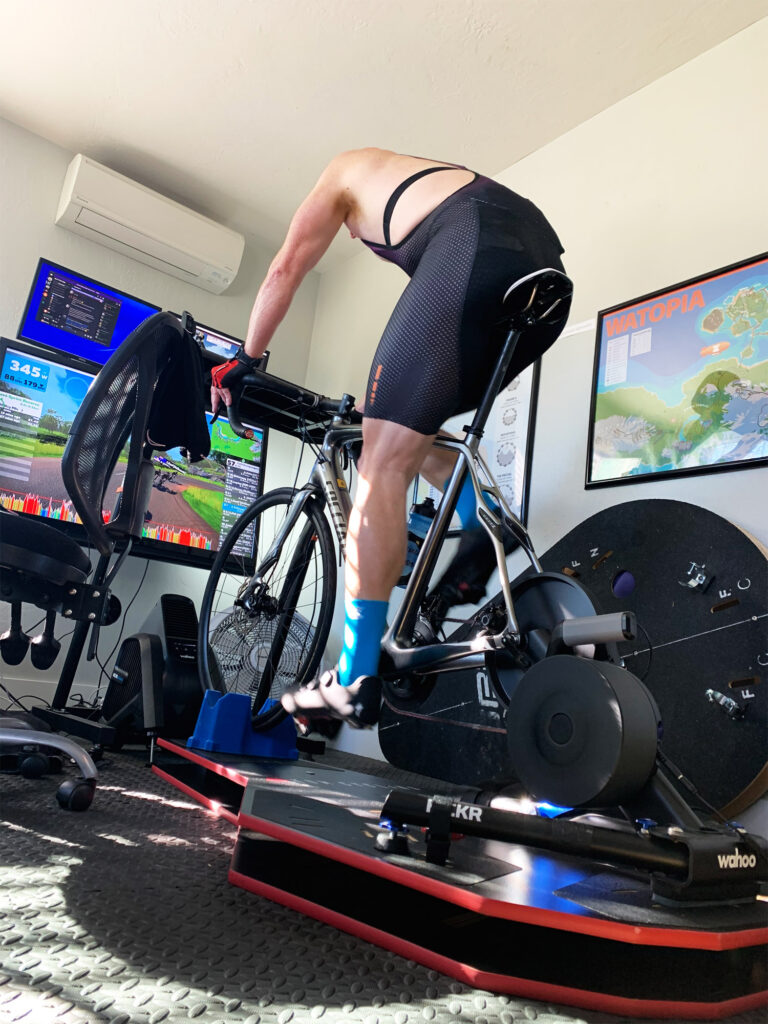Team time trials aren’t something I write about often, for two reasons:
- I don’t do them very often
- They’re usually not very interesting to read about
But yesterday I raced a TTT with my DIRT Hellhounds team, and it turned out to be the best TTT I’ve ever been a part of. And thus I’ve decided to write about: because I think you’ll find this post both interesting and helpful. Onward!
The Warmup
Zwift Racing League‘s Tuesday events are my priority races each week, so normally I do everything I can to be ready heading into race day. But this week I rode with a couple of buddies on Monday – one of those outdoor rides you just can’t say “No” to. After going a bit harder and further than I typically would on the day before a race, there was a bit of nagging worry in the back of my head that tired legs might impact Tuesday’s effort.
Tuesday I planned a solid warmup routine, coupled with my three favorite race-day products:
- Caffeine gum – two pieces (200mg), 1 hour before the race.
- PR lotion on my legs about 45 minutes before the race. More bicarb=less burning.
- The Nopinz Subzero kit, with freezer packs ready to insert when I had 20 minutes left.
This would also be my first day riding a new rocker plate I’m testing out from KOM Cycling. I had done a bit of setup to dial it in a few days earlier, but I was crossing my fingers and hoping there wouldn’t be any problems I would need to fix during today’s efforts!
The DIRT Hellhounds joined a private Meetup around 35 minutes before the race start time, and as we made our way around France’s R.G.V. route we chatted on Discord, rehearsed some rotations, and made sure our in-game setups were optimized. That meant three things for us:
- Having the fastest bike possible (most of us were on the Specialized S-Works Venge + Disc wheel)
- Changing our names in-game to use a number at the start, indicating our rotation order
- Making sure we each had different headwear, making it easy to spot each rider in-game
Soon enough it was time to hit the start pens. Let’s race!
The Start
It seems a bit silly, given how many thousands of riders participate in TTT’s every week on Zwift – but Team Time Trials are still a “hack” on Zwift. You’ll have a pile of teams in one start pen, but each team has been given a particular time delay by the race organizers. When the event clock hits zero, nobody leaves the pens. Instead, each team’s timekeeper begins counting down, so they can tell their team when to leave the pens.
Zwift really needs to improve this. But before that can happen, riders would need to be lumped together into teams – something which isn’t yet in place. It’ll happen… eventually.
The clock hit zero, and our timekeeper began his 7-minute countdown. We sat and spun our wheels, taking nervous pee breaks, making sure our towels and water were within reach, and chatting on Discord to pass the time.
We each had our Zwift pairing screens up so we could ride without moving out of the pens – then when the countdown hit 1 second we hit the Escape key, leaving the pairing screen and jumping out of the pens at a high wattage. This is the commonly-used “Pairing Screen Jump” used in TTT’s.
Dan, the #1 rider in our rotation, was set to take a 1-minute pull to start. I expected him to sprint hard and be the first from our team out of the pens, but as we exited I was in front! I didn’t ease up much, though – the TTT is all about speed, and if I was ahead of the team they could use my draft to join me as we got into our initial formation.
Soon enough we were flying in fine formation.

A DS and a Plan
Our team actually has 8 riders, giving us two substitutes in case of illness or injury. One of the strongest racers on our team is Tim Hanson, but unfortunately he couldn’t race this week since he’s recovering from injury. fortunately he makes a great DS! He was on Discord calling the rotations for us, and it worked really well.
The basic plan was single-file formation with 30-second pulls. As we neared the switch every 30 seconds Tim would give a 5-second warning to the rider who was about to start his pull, then let the rider know his pull had begun, and tell us who was on deck.
It may seem like a minor thing, but I found it super-relieving to have Tim giving us instructions. I didn’t have to think about my timings with Tim on the horn! Instead, my job was to sit on Dan’s wheel (I was #2 in the rotation), and when Tim said Dan had 5 seconds left I would up my watts to come around Dan, shooting to get my nose into the wind just as Dan’s pull ended. Then I just went hard until the #3 rider (Phil) came around me 30 seconds later.
Sink and Sprint + Slingshot
This 5-second “slingshot” was a new tactic for us. And it seemed to be working really well. Remember, the big goal is to keep the speed high, and that speed is determined by the front rider.
We didn’t want the 2nd rider slowed by the sticky draft if the front rider easedup before the 2nd rider came around for his pull. So the front rider’s job was to keep their power/speed up while the 2nd rider hit the watts hard to come around, benefiting from a bit of a slingshot. Once the 2nd rider had come around, the front rider would ease up dramatically to “sink” to the back of the line, putting in a quick sprint once they reached the back so they could grab onto the wheels again.
We caught our first team – the Vegans – just over halfway through the race as we hit the Aqueduc KOM. It always feels good to catch another team in a TTT! The pass was clean, and as we descended and took a bit of a recovery we all knew this race was going really well.
Far From Perfect
Still, our team formation was far from perfect. Generally the problems occurred when a rider would be sinking from the front to the back, and some teammates would get stuck behind that rider. It’s really a tough balance to strike, because as the sinking rider you can’t just stop pedaling – you would get dropped from the pack with no chance to get back on. So you have to ease up on your power just enough to sink back but not so much that you are dramatically dropped.
It’s easy to “overpower” your sink, which causes riders behind to get stuck on your wheel instead of coming around. It’s also easy to “underpower” your sink, so you can dropped off the back and have to sprint extra hard to catch back on.
It’s a team effort, really: every time the rotation changes, the back 4 riders need to be paying attention so they don’t get stuck behind the sinking rider. That means bumping up your wattage a bit just before encountering the sinker, so the sticky draft doesn’t grab you.
It’s fair to say each of the Hellhounds probably messed up a rotation here and there, but we recovered well. This was feeling good, and we were almost done.
The Finish
The R.G.V. finish is always tough, because you’re on the curvy rollers of Les Intestins, which make it impossible to hold a single file formation. Still, Tim was calling out the rotations, and I think this was good – it meant there was always at least one rider pushing hard to be on the front, even if they weren’t on the front. This meant the overall group speed stayed high.
As we began Les Intestins we passed a second team, DZR. Our #4 (Roger) had been struggling to hold on, and our acceleration through DZR was the straw that broke the camel’s back. He let us know on Discord that he was off the back, and we pressed on. 5 riders left.
Over the top of the climb portion of Les Intestins, Scott (or resident climber) pushed hard, keeping our speed up in that crucial section. It was too much for our #3 (Phil) though, and he announced he was dropping off. 4 riders left, with just 1.8km to go. This was it! DS Tim took it all in stride, calmly calling out the rotations.
With 1km left our #1 man (Dan) just in front of me was struggling to hold high power in the wind. Hard to blame him – we were all on the rivet! But I rolled past him on the slight descent, and decided to just keep the power high. I’ve learned from other TTT’s that I seem to often have a bit more in the tank for the final minute than other riders, and if I could stay on the front and lend a draft to the other three I wanted to do that.
800 meters left, and I was all in. But the watts were far from impressive! The other three came around me as we turned onto the main road before the start of the Marina Sprint, and I shifted, stood up, and began the final effort. I couldn’t even break 600 watts, but I was able to get back in the front and pull the team over the line. That always feels good!
Our final time: 33:24.313. This was the 4th fastest time of any B team in ZRL! Unfortunately, our division is super-strong, and that time got us 3rd place. Still, we were very happy with the result. In season 1, our team finished this same race in 34:28.375!
As I saved the ride, I was greeted with an FTP increase popup:

Woohoo! It’s been a long time since I got one of these.
See activity on Zwift >
See activity on Strava >
See race results on ZwiftPower >
Watch My Race Video:
(Sorry the Discord audio is too quiet, but at least you can hear my heavy breathing loud and clear!)
Watch the Race from DS Tim’s Point of View:
Takeaways
Two big takeaways from this race:
- A good DS is a big help. Having Tim calling the shots allowed us to focus on holding formation and keeping our power up. For me, at least, this narrowing of focus helped me perform better.
- The 5-second slingshot works well. We’ll be doing more of this.
Oh, and if you’re wondering: the rocker plate worked great. Good feel. More on this in an upcoming post where I’ll write a full review!
Your Thoughts
Did you race in yesterday’s TTT? Got any rotation, DS, or other tips to share? Comment below!


